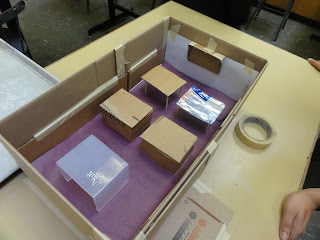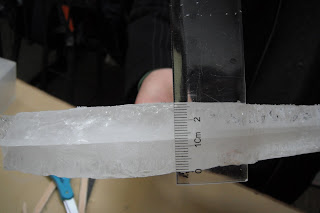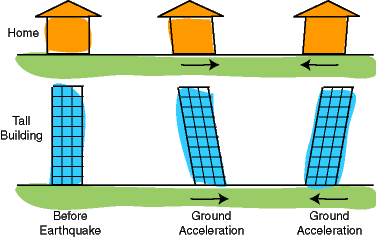Experiment Process:
We have just completed our investigation into whether or not the 'Triangle of life' void-identification theory is valid.
Our plan was to test if a 'pancake collapse', where the upper structure of a building falls onto the lower structure, would result in triangles being formed by the rubble in a classroom.
We initially constructed our model of a classroom in a cardboard box. In the bottom of the box, we placed a sheet of white paper. On top of that we placed carbon paper, with the intention that the falling 'rubble' would make marks on the white sheet where it hit the 'floor' of the model room, so we could analyse the way the rubble fell.. We placed four model tables in our model room, two were constructed to model sturdy desks (they were made of thick cardboard and the support structure of the desk was well built) and the other two were constructed to model weak school desks (they had light tops - one made of card and the other made of a thin sheet of aluminium drink can material - supported by thin legs made of bamboo skewers).
These were placed in the model room, along with a model book cabinet secured to the wall.
However, we quickly decided that this set-up had a major flaw; we could not see into the sides of the box to examine how the model rubble had fallen. So after only one trial (when we realised this flaw), we made a quick trip across the campus and found a fish tank to model a room, which we could photograph through the sides of.
We reset the model scene and proceeded to simulate our first 'pancake collapse', with bamboo skewers placed horizontally :
As you can see, the bamboo skewers had almost no effect on the model desks. But still, the skewers formed a lot of supporting structures around the desks, which indicates that the 'triangle of life' theory may be valid.
To examine the theory more closely, we changed the bamboo skewers to sheets of ice, which may crack and shatter just like concrete structures.
We repeated such experiment with ice sheets of different thickness (i.e. different mass).
Every time we can find some triangles formed around our model tables. For the weak tables which got tipped over, there was no chance for people to survive if hiding under them. Meanwhile, except for the last experiment in which one table got a little crushed, all the sturdy tables remained concrete in other experiments, which indicates that the 'duke and cover' method can remain useful in the cases which the covering is sturdy enough.
According to our original plan, we also wanted to use ice sheets frozen with cheese cloth to model concrete stuctures constructed with steel frames in them. However, we found this idea was unpractical since the ice can be hardly broken in such cases. We could even plunge metal rods through the sheets without breaking them. So this part of the plan was given up.
Conclusions and evaluations:
According to our modelling and experiment, we basically derived the following conclusions:
1) If one can find a sturdy structure as a cover, the 'duke and cover' method is apparently useful. However, if the cover is not sturdy enough, it may get tipped over or crushed so that the action of hiding oneself under a weak table is a kind of 'suiciding'.
2)In an earthquake there are some 'triangles of life' forming around tables or other structures. However, we still possess doubts towards such method because the forming of triangles are more or less a matter of chance in most cases. There is no certain pattern for the place where they may form, or in other words that one can hardly judge where to find such a place that triangles will form. Also it requires time to judge where may a triangle occur which may cause delaying in hiding in a real earthquake, and that is fatal in a real disaster. So although it seems that there's such a possibility for people adapting this method to survive, it is not a best choice. However if it's in a situation where no sturdy furnitures can be found, this method of 'triangle of life' is still recommended since there's still possibility for people adapting such method to survive.
Limitations:
One thing I have to emphasize here is that there is a tremenduous uncertainty in our experiment. We modelled a room and cracked ice sheets over it, but such modelling cannot cover all the real life situations. In real life situations, the meterial of the furniture, the meterial of the architecture(crispy or not, massive or not), even the settings and arrangement and indensity of the furnitures can make a difference (a room with indensely arranged tables is less likely to undergo a 'pancake collapse' than a room with only one or two tables inside). Any small and seemingly unimportant factor may have some effects in a complicated real-life situation so it's really hard to tell. There can hardly be any two identical situations, which require each single case should be treated differntly.
In our experiment, the modelling may also contains some uncertainty. The ice sheets is essentially not the same as concrete, nor concrete with steel frames. Even it can model concrete to some degree, it's hard to tell whether or not it can model wooden structures. The same problems happen with the modelling of furnitures as well. Furthermore, different structures of house (flat topped? slope topped?) cannot be examined in this experiment. And our way of breaking the ice with metal rods is obviously not the same as the way in which an earthquake destroy a house. In a real-life earthquake, the buldings would shake up and down first and then horizontally, which our modelling didn't fully express. Also different earthquake may cause different damage even to a same room and it's hard to predict the way the bulding collapse.
So combining all these together, we can only say that our experiment can only indicate that the 'triangle of life' theory may be good in some situations (especially without sturdy furniture) while 'duke and cover' seems to be more reliable in the situations with certain conditions (i.e. sturdy furniture). However, it requires more analysis and test to know whether or not these method can work. Our experiment is just a primary test.















